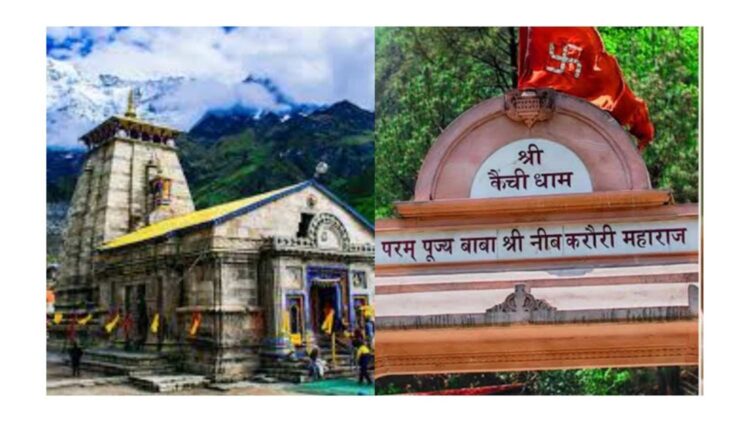The religious places of India, whose basic objectives have been spiritual peace, devotion and spiritual experience, are now becoming the center of social media attraction. While reverence and faith demands meditation and concentration, the developing digital world with modernity is leading it to the superficial appearance. The purpose of visiting religious places has turned from self -sufficiency and turned towards ‘Content Creation’. Now it is not necessary that people bow their heads in front of their God, it is important that they capture the grandeur there on camera and show it to the world by posting it on Instagram or Facebook. This change is becoming not only a social change, but is becoming a serious challenge for the identity of our religious and cultural heritage.
From the holy dhams of the Himalayas to the ghats of Kashi, from the Golden Temple of Amritsar to the streets of Vrindavan, places filled with reverence have now been made a selfie point. Kedarnath Dham, which was once famous for his difficult journey and spiritual energy, now people reach there with Gopro cameras. During the Ganga Aarti, earlier people used to close their eyes and get absorbed in devotion, now there is a competition to record videos from the camera. Putting pictures and videos of these sites on social media may have increased tourism, but the real form of reverence is becoming weaker.
There are many reasons for this change. First, the digital age has removed the identity of religious places from devotion to ‘tourist destination’. Tourism companies are promoting them, as if they are only places to roam and have fun. Chardham Yatra has now become a ‘package tour’, not just a religious ritual. Hotels, cafes, adventure sports, heli-tourism, ropeway-all of them have converted spiritual sites into markets. Secondly, social media and influencer culture have further promoted it. Now everywhere YouTube is visiting Vlogers and Instagram Influencer religious places, but their focus is more than the sanctity and devotion there, making good videos and getting likes-cakes.
The effect of this changing identity of religious places is also serious. The biggest effect is that the depth of devotion and reverence has been lost. Earlier, where people used to meditate in the temple for hours, now they stop there for just a few minutes and take photos and move forward. Earlier religious trips were the opportunity of introspection and self -purification, now they have just become a trend. The sanctity and peace of these sites have also been affected due to increasing crowds. Earlier, silence and spirituality were felt in temples and gurudwaras, now the flash lights and noise of cameras have dominated there.
Both society and the government need to take concrete steps to prevent this change. First of all, the government will have to implement strict rules at religious places, so that their sanctity is maintained. For example, the use of cameras and mobile phones should be imposed inside these sites, just as Tirupati is already applicable in Balaji Temple and Golden Temple. Such rules already exist in foreign countries. In Japan, carrying mobile phones in many Buddhist monasteries is strictly forbidden, so that the atmosphere of meditation and peace remains. In the churches of Vatican City, people cannot take a mobile camera and take photos. There is also a need to implement such rules in India, so that religion and spirituality can be saved from market and showing.
In addition, commercialization of religious places must be controlled. Now the concept of ‘VIP Darshan’ has started in many temples, where those who give more money get a chance to see early. It is against the basic spirit of religious places. The commercialization of religion not only reduces the dignity of these sites, but also increases the feeling of inequality among the devotees. The government should enact strict laws on commercialization of temples and religious institutions, so that religion can be prevented from becoming a market.
Society also has to understand this change. We have to consider our priorities. Do we go to religious places to find spiritual peace or to show our presence only on social media? Shraddha is not only from the external appearance, but it is an inner feeling. When we visit these places, it is important that we spend time there with devotion and faith, not standing behind the camera and keep searching the right angle.
Many measures have been taken to avoid this problem in other countries. Israel has special security guards to maintain religious discipline at the holy sites of Jerusalem, which prevent noise and unfair activities. Specific areas have been created for meditation and practice on places associated with Buddhism, where tourists have to maintain complete peace. Such measures should also be taken in India. Special areas can be created for meditation and devotion at temples and other religious places, where mobile phones are banned and devotees are allowed to worship peacefully.
Finally, in this struggle of reverence and show, we have to decide in which direction we want to go. Do we want to make religion superficial by making it just a trend, or do we want to maintain it in its original form? This change will have to be brought into our mindset. As long as people themselves do not understand that Shraddha means not only to take pictures, but to feel it, then this problem will not be solved.
Religion is not just a tradition, but an experience of faith and spirituality. If we limit it only to tourism and social media, its depth will be lost. Therefore, it is time to understand our responsibility and take necessary steps to save the dignity of our religious places. As long as selfie is more important than reverence, religion will remain only a pretense. We have to maintain it from a show, maintaining a medium of spiritual peace and devotion.






